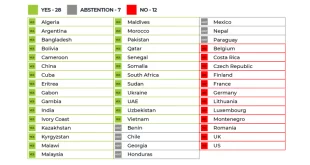Appendix A Excerpted from “Human Rights in Islam” by ‘Allamah Abu Al-‘A’la Mawdudi. Chapter 3, subsection 5 – Al Tawhid Journal, vol. IV. No. 3 Rajab-Ramadan 1407. 5.
Individual’s Right to Freedom:
Islam has clearly and categorically forbidden the primitive practice of capturing a free man, to make him a slave or to sell him into slavery. On this point the clear and unequivocal words of the Prophet are as follows:
“There are three categories of people against whom I shall myself be a plaintiff on the Day of Judgement. Of these three, one is he who enslaves a free man, then sells him and eats this money” (al-Bukhari and Ibn Majjah).
The words of this Tradition of the Prophet are also general, they have not been qualified or made applicable to a particular nation, race, country or followers of a particular religion. The Europeans take great pride in claiming that they abolished slavery from the world, though they had the decency to do so only in the middle of the last century. Before this, these Western powers had been raiding Africa on a very large scale, capturing their free men, putting them in bondage and transporting them to their new colonies. The treatment which they have meted out to these unfortunate people has been worse than the treatment given to animals. The books written by the Western people themselves bear testimony to this fact.
The Position of Slavery in Islam:
Briefly I would like to tell you about the position and nature of slavery in Islam. Islam tried to solve the problem of the slaves that were in Arabia by encouraging the people in different ways to set their slaves free. The Muslims were ordered that in expiation of some of their sins they should set their slaves free. Freeing a slave by one’s own free will was declared to be an act of great merit, so much so that it was said that every limb of the man who manumits a slave will be protected from hell-fire in lieu of the limb of the slave freed by him.
The result of this policy was that by the time the period of the Rightly-Guided Caliphs was reached, all the old slaves of Arabia were liberated. The Prophet alone liberated as many as 63 slaves. The number of slaves freed by ‘Aishah was 67, ‘Abbas liberated 70, ‘Abd Allah ibn ‘Umar liberated one thousand, and ‘Abd al-Rahman purchased thirty thousand and set them free. Similarly other Companions of the Prophet liberated a large number of slaves, the details of which are given in the Traditions and books of history of that period. Thus the problem of the slaves of Arabia was solved in a short period of thirty or forty years.
After this the only form of slavery which was left in Islamic society was the prisoners of war, who were captured on the battlefield. These prisoners of war were retained by the Muslim Government until their government agreed to receive them back in exchange for Muslim soldiers captured by them, or arranged the payment of ransom on their behalf. If the soldiers they captured were not exchanged with Muslim prisoners of war, or their people did not pay their ransom money to purchase their liberty, then the Muslim Government used to distribute them among the soldiers of the army which had captured them. This was a more humane and proper way of disposing of them than retaining them like cattle in concentration camps and taking forced labour from them and, if their women folk were also captured, setting them aside for prostitution. In place of such a cruel and outrageous way of disposing of the prisoners of war, Islam preferred to spread them in the population and thus brought them in contact with individual human beings. Over and above, their guardians were ordered to treat them well.
The result of this humane policy was that most of the men who were captured on foreign battlefields and brought to the Muslim countries as slaves embraced Islam and their descendants produced great scholars, imams, jurists, commentators, statesmen and generals of the army. So much so that later on they became the rulers of the Muslim world.
The solution of this problem which has been proposed in the present age is that after the cessation of hostilities the prisoners of war of the combatant countries should be exchanged. Whereas Muslims have been practising it from the very beginning and whenever the adversary accepted the exchange of prisoners of war from both sides, it was implemented without the least hesitation or delay.
In modern warfare we also find that if one government is completely routed leaving her in no position of bargaining for the prisoners of war and the winning party gets its prisoners easily, then experience has shown that the prisoners of war of the vanquished army are kept in conditions which are much worse than the conditions of slaves.
Can anyone tell us what has been the fate of the thousands of prisoners of war captured by Russia from the defeated armies of Germany and Japan in the Second World War? No one has given their account so far. No one knows how many thousands of them are still alive and how many thousands of them have perished due to the hardship of the Russian concentration and labour camps.
The forced labour which has been taken from them is much worse than the service one can exact from slaves. Even perhaps in the times of ancient Pharaohs of Egypt such harsh labour might not have been exacted from the slaves in building the pyramids of Egypt, as has been exacted from the prisoners of war in Russia in developing Siberia and other backward areas of Russia, or working in coal and other mines in below zero temperatures, ill-clad, ill-fed and brutally treated by their supervisors.
The Slave Trade of Western Nations:
After the occupation of America and the West Indies, for three hundred and fifty years, traffic in slave trade continued. The African coasts where the black-skinned captured Africans were brought from the interior of Africa and put on the ships sailing out from those ports, came to be known as the Slave Coast.
During only one century (from 1680 to 1786) the total number of free people who were captured and enslaved only for British Colonies amounts, according to the estimate of British authors, to 20 million human beings. Over the period of only one year (1790) we are told that 75,000 human beings were captured and sent for slave labour in the Colonies. The ships which were used for transporting the slaves were small and dirty. These unfortunate Africans were thrust into the holds of these ships like cattle right up to the top and many of them were chained to the wooden shelves on which they could hardly move because these were only eighteen inches apart, kept one on top of the other. They were not provided with suitable food, and if they fell ill or were injured, no attempt was made to provide them with medical treatment.
The Western writers themselves state that at least 20% of the total number of people who were captured for slavery and forced labour perished during their transportation from the African coast to America. It has also been estimated that the total number of people who were captured for slavery by the various European nations during the heyday of the slave trade comes to at least one hundred million. This is the record of the people who denounce Muslims day and night for recognizing the institution of slavery. It is as if a criminal is holding his finger of blame towards an innocent man.
 Sri lanka Muslims Web Portal Diversity and Inclusiveness
Sri lanka Muslims Web Portal Diversity and Inclusiveness




It is generally accepted that the awrah of a slave-girl is similar to that of a man’s, namely that portion between the navel and knees. This would of course suggest that her breasts could be uncovered in the presence of strange men. Of course what we must bear in mind is that the attitude towards slaves in general under Islamdom was very much more liberal than that which applied to free persons. For instance according to the Qur’an a slave-woman who committed zina was to receive only half the punishment that would apply to a free woman in a similar case (fa alayhinna nisfu ma ala’l muhsanati) (4:25) and from this derives the principle that the hadd of a slave must always be half as that prescribed for a free person and this even applied to slaves who infringed on the Islamic prohibition of drinking wine in the days of the early Caliphs which meant that they received only half the number of lashes which a free person would receive if found guilty of this sin.
I certainly agree with Br Asiff that slaves under Islam were given much better treatment than under any other dispensation. There is plenty of data to support that view. I am interested in one point. Is it correct that female slaves were not kept in seclusion and were not veiled in any form unlike the free women? Could Br Asiff or others enlighten?
Basically I think many of us still misunderstand the position of slavery in Islam. This is not a question of anybody being enslaved at one’s whim and fancy. There is a clear injunction that Muslims cannot be enslaved and indeed strictly speaking slaves could only be taken from among the prisoners of war after a lawful Jihad proclaimed by established Islamic authority has been waged against them only after they are given the choice of either submitting to Islam, or else paying Jizya or Poll Tax, refusal of which meant war.
The captives who fall into the hands of the Islamic army thereby come under the care of the Islamic authority which will allot them to those whom it deems fit as slaves. Such slaves are to be treated with the utmost kindness, so much so indeed that they should be fed with the food of their masters and clothed with their clothes. Nor should they be harmed in any way. Islam also provided ample opportunity for such slaves to be liberated either by way of a payment for freedom or by way of expiation of a sin. The early history of Islam provides numerous instances of how well slaves were treated, so much so indeed that there were illustrious ruling dynasties such as the Mamelukes that had their origins in slaves. Indeed the treatment of slaves in Islam differed radically from the harsh treatment meted out to them as late as the 18th century in the US where they were treated as sub-humans and valued only for their labour which was ruthlessly exploited by their masters.
The practice of enslaving ordinary people such as happened in the olden days when Africans were enslaved by unscrupulous Arab Slave dealers without any call to Islam whatsoever has no place in Islam.
One could even argue that the recognition of the institution of slavery in Islam was prompted by a consideration of the position of prisoners of war whom we all know were harshly treated even until recent times in the West. Enslaving captives also gave them certain rights which could not be transgressed by their masters and above all ensured that they would be well treated, so much so indeed that a slave-girl could not even be married or forced into prostitution against her will. Contrast this with the attitude of other nations to their prisoners of war as for instance the Killing of innocent hostages including children by England’s Richard ‘the Lionheart’ at the height of the crusades or the position of the Korean ‘Comfort women’ who fell into the hands of the Japanese army during the Second World War.